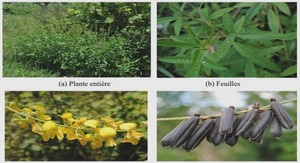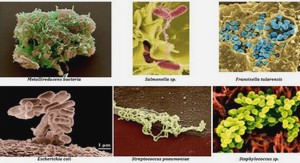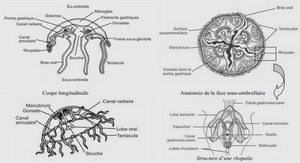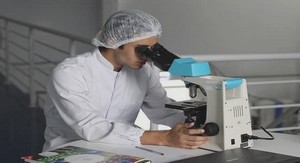Les assemblages de larves de poissons deans le lagon de Nouvelle-Calédonie
Material and methods
Study site
Sampling took place in the south-west lagoon of New Caledonia, south-west Pacific, 100 km north of Nouméa, in Ouano/La Foa (Fig.1). The area was impacted by a strong cyclone in 2003 (Wantiez et al. 2006) and is still characterized by a relatively poor coverage in livecorals compared to other areas in the south-west lagoon of New Caledonia (Wantiez 2008). In most places, abiotic substrates of low structural complexity such as sand, coral rubbles and coral pavement dominate, while biotic substrates mainly consist of algae and seagrasses. Resident fish were sampled at 25 stations from the coast to the 7 km distant barrier reef; ten stations were located near the coast (C1 to C10), nine were in the intermediate lagoon (L1 to L9) and six were along the inner-reef slope of the barrier reef (B1 to B6; Fig.1). Larvae were collected at three stations, each located close to a group of stations where resident fish were sampled (C0: near the coast, L0: in the intermediate lagoon and B0: close to the barrier reef; Fig.1).
Sampling design
Underwater visual counts (UVC) based on the “point transect” method (Buckland et al. 2001) were used to sample resident fish. Each station consisted of three points. For corallian habitats, these three points were randomly distributed among the three principal geomorphologic units, i.e., the reef flat, the reef crest and the reef slope. In seagrass and seaweed beds, and in the zones of scattered coral colonies, these three points were randomly located. Each point was sampled by two scuba-divers who resensed fishes within circular concentric zones. After a waiting period of 5 minutes aimed at limiting the disturbances generated by the divers, one diver concentrated on the large species within a circle of 10 m around him while the other resensed the small species inside a circle of 3 m. For each species, each diver noted the number of individuals. This technique increases the efficiency of UVC as 115 it classifies fish species into two groups of different sizes, behaviors and detectability (Wantiez and Chauvet 2003). After UVC, the benthic substrate was described at each station along three 25 m long transects. These transects were centered on the UVC points, and parallel to the slope in corallian habitats, following the “Line Intercept Transect” method (English et al. 1994). A total of eight categories of benthic substrates were retained: live coral, dead coral, sponges and soft corals, seaweeds, seagrasses, sand, coral rubbles, and coral pavement (i.e., cemented coral rubbles and rock). One diver noted the length, in cm, covered by each category along the transect centerline. Fish larvae were collected using light-traps, which are known to target larvae at the end of their pelagic life, just before they settle on benthic habitats (Choat et al. 1993; Hickford and Schiel 1999; Anderson et al. 2002). On the other hand, light-traps also present the disadvantage of selectively attracting only taxa characterized by a phototactic positive response during the larval stage (Brogan, 1994). However, light-traps are the only available sampling gear enabling to evaluate larval abundances in different habitats synoptically (Doherty et al. 1987; Thorrold and Williams 1996). The following comparisons rely on the postulate that the larvae collected in a particular area were about to settle on the underneath habitat, so that the larvae obtained by light-trapping near a specific habitat were expressing their preference for this habitat. At each station, light-traps developed by the Ecocean Society (Saint-Clément-de-Rivière, France) were set under the surface and a timer allowed setting on the lamp automatically seven hours per night, from 22:00 pm to 05:00 am. Each light-trap consisted of a buoyant water-tight block containing a 6 V battery and a 7 W neon lamp under which a 2 mm mesh size conical net was attached vertically (INPI deposited patent n°0208582). Once the net was pulled out of the water, fish were retrieved in a removable collector, anaesthetized in 0.75 g l-1 benzocaine, and immediately preserved in 95% alcohol. Sampling occurred during the warm season, when larval fish are abundant in the lagoon (Carassou and Ponton 2007 -“A1”-). Resident fish were sampled at each station between October and November in 2004 and 2005. Larval fish were sampled at each station from November 2004 to January 2005 and from September 2005 to February 2006. Light-traps were set once a month for four successive nights to take into account the high temporal 116 variability characterizing light-traps catches (Choat et al., 1993), and as close as possible to new moon periods in order to optimize their efficiency (Wilson 2001).
Laboratory work and data analysis
In the laboratory, fish larvae were identified to the family level following Leis and Trnski (1989), and Leis and Carson-Ewart (2000). Resident fish were also gathered by families. Total density at each station was calculated as follows: 3 3 1 ∑= = k Dk D with D: total density of fish of a given family at the station considered (fish.m- ²); Dk: density of fish of a given family at point k from the station considered. The density of fish of a given family at point k was calculated as follows: ² ² 2 1 1 1 R n R n Dk s l N j j N i i π π ∑ ∑ = = = + with ni: abundance of large sized species i of the family at point k; Nl: total number of large sized species of the family observed within a visibility radius R1 (R1 ≤ 10 m) at point k; nj: abundance of small sized species j of the family at point k; Ns: total number of small sized species of the family observed around a visibility radius R2 (R2 = 3 m) at point k. The proportion (Pi in %) of the eight benthic substrate categories recorded at each station was calculated as follows: ∑= = × 3 1 100 3 1 k t ik i L L P with Pi: relative coverage of category i; Lik: total length represented by category i at point k; Lt: total length of the transect (i.e., 25 m). The data analyses consisted firstly of listing the families collected both at larval and at resident stages, that is the families which were both observed by UVC and caught by lighttraps. These families were then sorted out, and all the following analyses were based on these common families alone. Benthic coverages were used to gather the UVC stations performed in identical habitat types. This was done using a complete linkage hierarchical clustering based on the normalized euclidean distances between the benthic coverages measured at each station (Clarke and Gorley 2006). 117 Figure 2: Groups of habitat and relative densities of resident fish families in each habitat (only families shared by larval and resident fish assemblages are considered). With a) groups of stations determined by hierarchical clustering based on benthic coverages, b) mean benthic coverages in each group, c) dominance plots of resident fish assemblages in each group of habitat. See Fig.1 for the location of the sampling stations and Table 1 for codes of families. With LC: live corals, DC: dead corals, SpSc: sponges and soft corals, SW: seaweeds, SG: seagrasses, S: sand, CR: coral rubbles, CP: coral pavement. Each habitat is designated by its major benthic categories.
The relative proportions (% of the total density) of families in resident fish assemblages were determined for each habitat. Since mean benthic habitat coverage and mean resident fish families proportions did not vary significantly between the two years of sampling (MannWhitney tests, P>0.05), these data were averaged for both years. The relative proportion (% of the total abundance) of families in larval assemblages was then determined for each light-trap station and for each month. Non parametric analyses of similarities (ANOSIM) based on Bray-Curtis similarity matrices built on the abundance ranks of families were then performed in order to compare the structures of larval assemblages from each station or month with the structures of resident fish assemblages from each habitat. All the analyses were performed using Primer v5 (Clarke and Gorley 2006).
Results
Composition and structure of resident fish and larval assemblages A total number of 59 fish families were observed: 32 as resident fish, and 48 as larvae (Table 1). A total of 11 families were observed as resident fish only and 27 collected as larvae only. Conversely, 21 families were both observed by UVC and collected by light-traps (Table 1). All subsequent results will rely on these 21 families only. Based on hierarchical clustering on benthic coverages, five habitat types were identified: seaweed or seagrass beds, sand, coral rubbles and coral pavement (Fig.2a). Each habitat type harbored characteristic families: Lethrinidae, Caesionidae and Scaridae where seaweed beds dominated; Lethrinidae, Mullidae and Labridae where seagrass beds dominated; Caesionidae, Labridae and Apogonidae in stations covered mainly by sand, followed by coral pavement and scattered seaweeds; Caesionidae, Nemipteridae and Labridae in stations covered mainly by coral rubbles, and Scaridae, Labridae and Caesionidae in stations where coral pavement dominated (Fig.2b and 2c).
The larval fish assemblages were also structured spatially
Apogonidae were abundant at the coastal and lagoonal stations, followed by Carangidae and Siganidae at the coastal station, and by Pomacentridae and Lethrinidae at the lagoonal station (Fig.3a and 3b). Pomacentridae represented the most abundant family at the barrier reef station, followed by Gobiidae and Apogonidae (Fig.3c). Apogonidae was the most abundant family in larval assemblages during five out of the nine months of sampling (Table 2). Similarities between resident fish and larval fish assemblages Similarities were observed between resident fish assemblages and larval assemblages caught in specific habitats and/or at specific months only. When the larvae collected at different months and stations were considered together, no significant difference with the resident fish assemblages inhabiting seaweed beds or sandy bottoms were observed (P>0.05; Table 3). When sampling stations were considered separately, no significant differences were found 1) between the larval assemblages obtained at the lagoon and the barrier reef stations and the resident fish assemblage observed in seaweeds beds, and 2) between the larval assemblage obtained at the lagoon station and the resident fish assemblage observed in seagrass beds (P>0.05; Table 3). When sampling months were distinguished, the larval assemblage was similar to resident fish assemblage from seagrass beds at all months. Conversely, the larval assemblage was similar to resident fish assemblages from seaweed beds and sandy bottoms from November 2004 to January 2005 only. Significant differences were observed between larval and resident assemblages inhabiting coral rubbles and coral pavement, whatever the sampling month or station considered (P<0.05; Table 3).
AVANT-PROPOS : ORGANISATION DE LA THÈSE |




